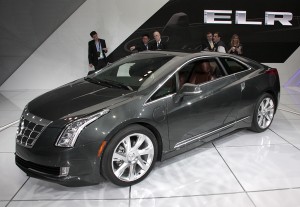With signs that sales of its Chevrolet Volt battery car could be coming unplugged, General Motors is offering potential buyers as much as $5,000 in incentives – making it the latest maker to try to cut prices in a bid to boost lagging demand for electric vehicles.
Whether the move will work remains to be seen, as GM has already trimmed the price on the Volt plug-in hybrid. But rival Nissan has had some clear success after cutting the price on its own Leaf battery-electric vehicle, or BEV, earlier this year.
Both vehicles were introduced to high expectations nearly three years ago, but they have so far consistently missed sales targets. In fact, only a handful of battery-based vehicles have come close to meeting expectations, most notably the Tesla Model S.
That might be enough to convince a maker to pull the plug on a vehicle like Volt. But manufacturers like GM and Nissan are under heavy pressure to make their electric vehicle programs a success – at almost any cost – in part because of pressure they face in the nation’s largest state, California, where regulators require all major makers to offer a minimum number of so-called Zero-Emission Vehicles.
A California buyer can now purchase a Chevrolet Volt for as little as $28,495. The base price for the plug-in is $39,995 but all buyers qualify for $4,000 off on a 2013 model and $5,000 off for a 2012 Volt. They also can get an extra $1,000 if they are currently leasing a non-GM vehicle. Meanwhile, the federal government provides a $7,500 tax credit while the state kicks in another $1,500.
A number of other states now offer incentives to buyers of qualifying battery vehicles, as well.
Chevrolet also is now reducing lease pricing for the Volt to $269 a month for 36 months, with a $2,399 downpayment.
(Honda slashes lease prices for the Fit EV by a third. Click Here for more details.)
Initially, demand for the Chevrolet Volt outpaced all its rivals but still fell short of its 10,000-unit U.S. sales goal in 2011 and an even more ambitious target of around 45,000 last year.
For the first five months of this year, GM has sold only 7,157 of what it prefers to call an extended-range electric vehicle, or E-REV. May sales, in particular, fell 4.3%, to 1,607. By comparison, the overall U.S. automotive market was up 8.2% for the month.
According to a report by Inside EVs, Chevy dealers have more than 9,000 Volts clogging inventories, vehicles they need to clear out before the 2014 models start rolling in.
(Hyundai confirms plans to bring an EV to the U.S. Click Here for that story.)
The downturn in demand presents other problems for GM. The maker had high hopes for its electrification program and has been planning to use the underlying platform for additional models. So far, only two have been identified publicly. The Opel Ampera, a near twin of the Volt, is already on sale in Europe, China and a few other markets.
Meanwhile, GM plans to roll out a more lavish – and significantly more costly – plug-in model next year, the Cadillac ELR. There has been an ongoing debate within General Motors over the original decision to go to market with a relatively mainstream battery-car like the Chevrolet Volt, rather than focus on up-market customers with something like the ELR.
That’s the strategy Tesla has taken with the Model-S for which demand exceeded the start-up maker’s expectations during the first quarter — and which is now outselling the Volt. A well-equipped Model S with a 300-mile battery pack can top the $100,000 mark, yet Tesla has found demand for its high-end version so strong it dropped the least expensive, 160-mile model recently.
Among mainstream makers, however, price is clearly an object of resistance among potential buyers. That prompted Honda last month to reduce the lease price on its new Fit EV by a third, to $259 a month. Nissan, meanwhile, effectively reduced the price of the Leaf by 18%, or $6,000, when it launched a new, stripped-down model at the beginning of the year.
That followed 2012 sales that fell well short of target, acknowledged Nissan CEO Carlos Ghosn, calling it, “a disappointment for us.”
Makers like GM and Nissan have promised to reduce battery car prices as the cost of the underlying technology – especially their lithium-ion batteries – falls. GM officials have hinted the next-generation Chevy Volt could be “thousands” less.
But despite the high price tags for current models, buyers are still getting a bargain. Industry analysts have estimated it actually costs GM as much as $75,000 to build each Volt, or nearly twice the base price. While the maker won’t discuss such details, Fiat/Chrysler CEO Sergio Marchionne has publicly confirmed that the company will lose at least $10,000 for each of the Fiat 500e electric vehicles it recently introduced.



So much for the pie-in-the-sky Volt sales predictions. The U.S. car makers are going to be in deep trouble when they can’t convince people to buy EVs and hybrids to meet the absurd 54.5 CAFE requirements.
Sales of Chevy Volt coming “unplugged”? That presupposes that sales since its introduction have been “plugged in”. From what I’ve read, sales have always lagged expectations. I recall that production was even halted last year or the year before, to allow “demand” to catch up with supply.
Considering that Chevrolet, Nissan, et. al. have never even attempted to quantify the savings of an electric…or, for that matter, any other benefit… no surprise that there’s resistance (see what I did there?) in the market to them.
With gas spiking yet again, fracking or no, the prospect of 1.13/gal driving may start to look very attractive again.
That electricity ain’t free… You pay one way or the other. I’m waiting to see how many EVs and hybrids end up in the toxic waste scrap pile immediately after the factory warrantied expires. Who is actually going to be able to maintain these vehicles and at what costs as the cars are heavily subsidized cost wise and replacement parts are only available from the maker at astronomical prices no doubt thus these are basically disposable cars with a heavy depreciation that needs to be considered in the big scheme of life and TCO.